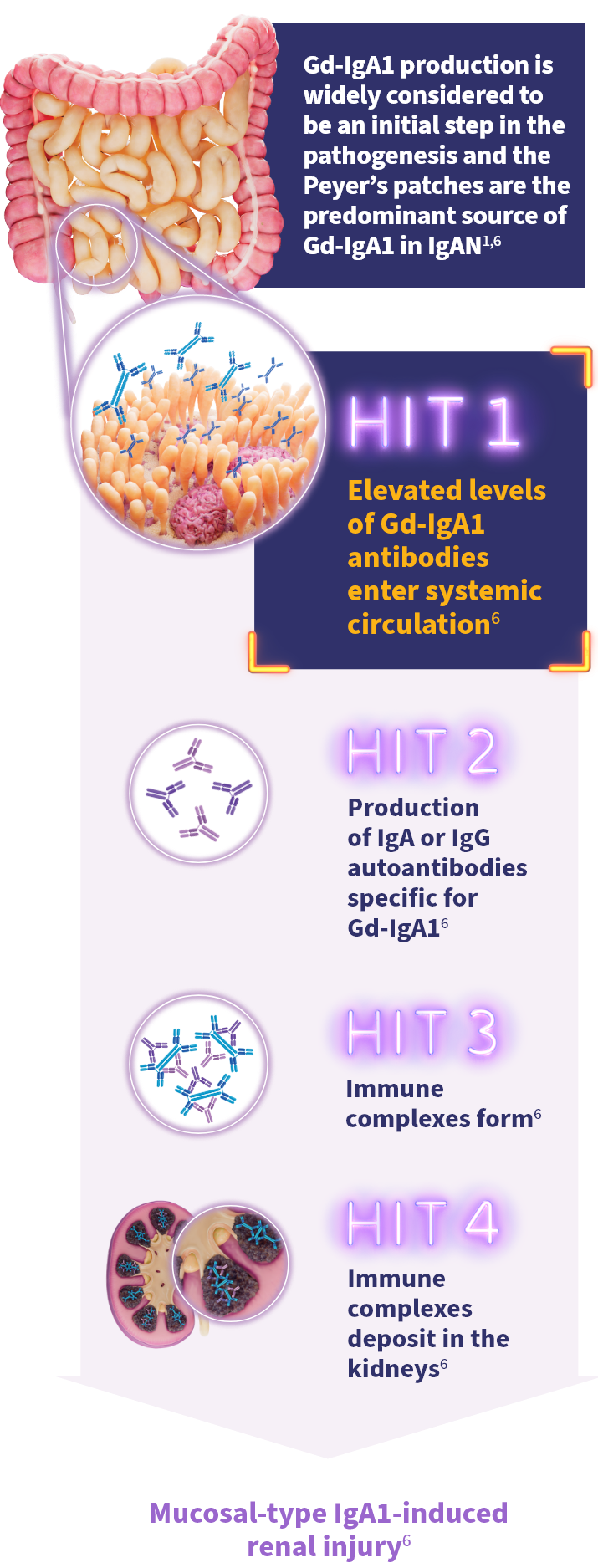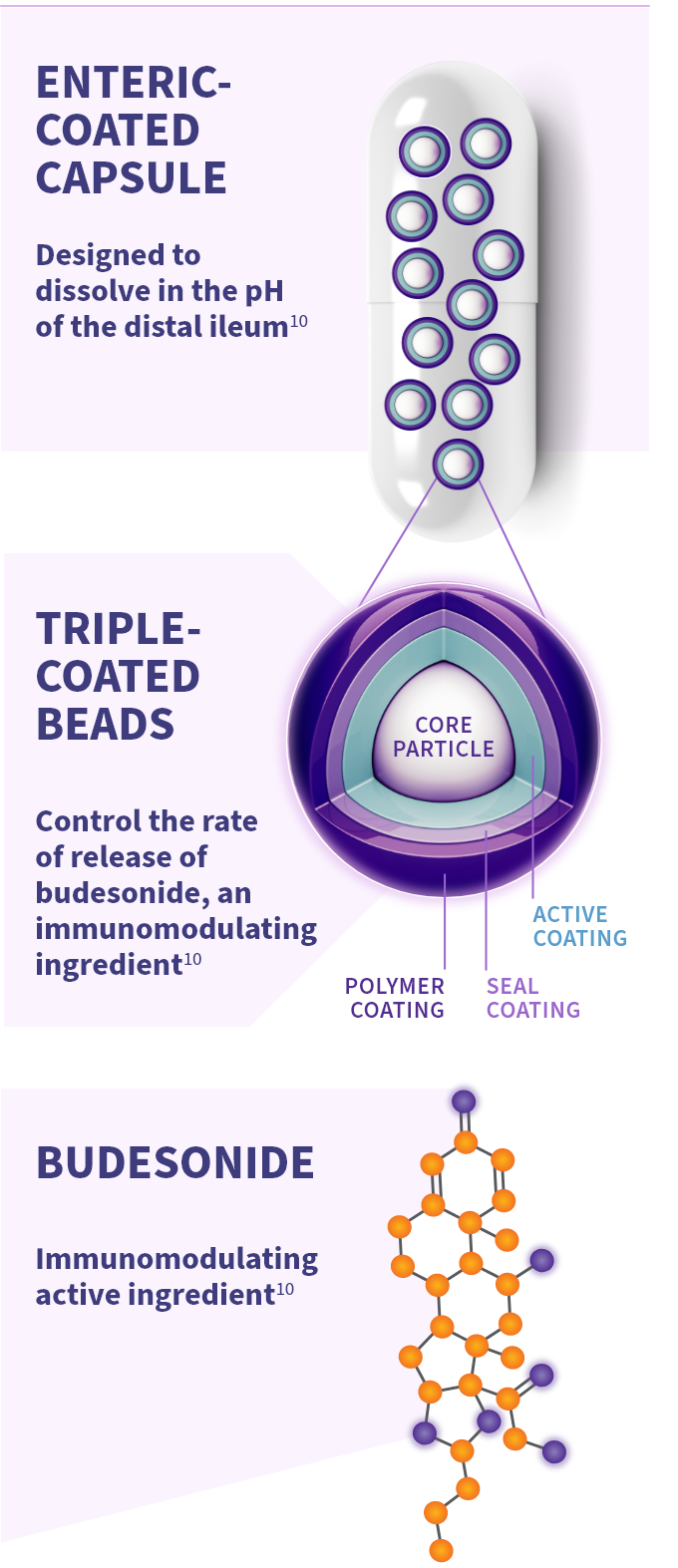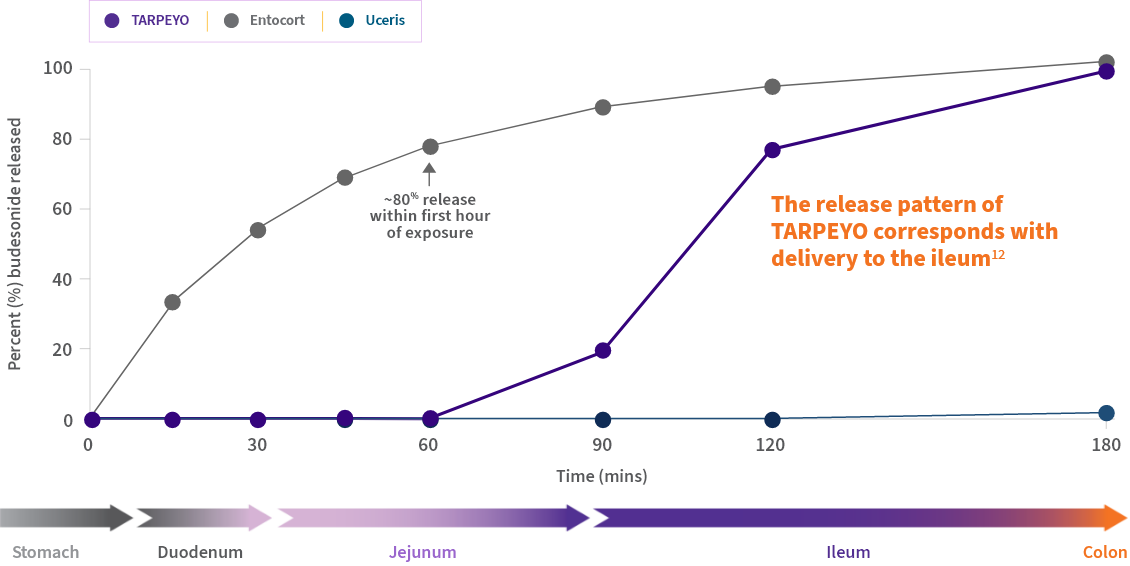
ELEVATED Gd-IgA1 IS ASSOCIATED WITH IMMUNE COMPLEX FORMATION AND MESANGIAL DEPOSITION1
- The gut-kidney axis plays a significant role in the pathophysiology of IgA nephropathy2
- Peyer’s patches are lymphoid follicles within the GALT that are in greatest concentration in the distal ileum where the majority of Gd-IgA1 is thought to be produced2
- Gd-IgA1 is an emerging biomarker that has been correlated with CKD progression3
NEARLY

of Peyer’s patch tissue has been shown to be found in the distal ileum4,5
IgA NEPHROPATHY (IgAN) IS A PROGRESSIVE IMMUNE-MEDIATED DISEASE WHERE EARLY MODULATION IS IMPORTANT2,6
The widely accepted 4-HIT model illustrates the pathogenesis of IgAN6:



TARPEYO IS A TARGETED-RELEASE CAPSULE DESIGNED TO DELIVER BUDESONIDE TO A KEY SITE OF Gd-IgA1 PRODUCTION10


Local action and first-pass metabolism
- Budesonide is a locally acting glucocorticoid designed to limit systemic exposure due to high rate of first-pass liver metabolism10
Shorter half-life and exposure duration
- In pharmacokinetic studies comparing TARPEYO and Entocort, TARPEYO exhibited higher maximum plasma concentrations of budesonide while having a shorter terminal half-life, indicating a shorter duration of systemic exposure to budesonide11
Clinical significance is unknown.
Prolonged retention
- Developed for topical use on mucosal surfaces, budesonide exhibits rapid absorption and prolonged retention in mucosal tissue10
It has not been established to what extent the efficacy of TARPEYO is mediated via local effects in the ileum vs systemic effects.
TARPEYO IS THE ONLY FORMULATION OF BUDESONIDE DESIGNED TO TARGET THE PEYER’S PATCHES OF THE ILEUM10,12
An in vitro study compared the release patterns of commercially available oral budesonide products. Its aim was to determine if the products are interchangeable regarding their delivery of budesonide to the GI tract.12*
Findings suggest that the release pattern of TARPEYO is consistent with the intended design of the product, to deliver budesonide to the Peyerʼs patch-rich area of the ileum.12
Dissolution profiles of 3 delayed-release budesonide oral formulations12,13


Approximate GI tract transit time (highly variable; illustrative only and not intended to compare efficacy and safety). TARPEYO was studied under the name Nefecon.
- TARPEYO demonstrated a unique dissolution profile compared to other budesonide formulations, including Entocort12
- The release pattern of TARPEYO indicates that the delivery of budesonide would occur in the ileum12
*Dissolution test conditions were conducted based on EMA, FDA, and USP guidelines.12
EMA=European Medicines Agency; FDA=Food and Drug Administration; GALT=gut-associated lymphoid tissue; Gd-IgA1=galactose-deficient IgA1; GI=gastrointestinal; IgA1=immunoglobulin A1; IgG=immunoglobulin G; USP=United States Pharmacopeia.
REFERENCES: 1. Lim RS, Yeo SC, Barratt J, et al. An update on current therapeutic options in IgA nephropathy. J Clin Med. 2024;13(4):947. doi:10.3390/jcm13040947 2. Barratt J, Rovin BH, Cattran D, et al. Why target the gut to treat IgA nephropathy? Kidney Int Rep. 2020;5(10):1620-1624. doi:10.1016/j.ekir.2020.08.009 3. Kim JS, Hwang HS, Sang HL, et al. Clinical relevance of serum galactose deficient IgA1 in patients with IgA nephropathy. J Clin Med. 2020;9:3549. 4. Jung C, Hugot J-P, Barreau F. Peyerʼs patches: the immune sensors of the intestine. Int Journal Inflammation. 2010;1-12. https://doi.org/10.4061/2010/823710 5. Van Kruiningen, H, West AB, Freda BJ, et al. Distribution of Peyerʼs patches in the distal ileum. Inflammatory Bowel Dis. 2002;8(3):180-185. https://doi.org/10.1097/00054725-200205000-00004 6. Chang S, Li X-K. The role of immune modulation in pathogenesis of IgA nephropathy. Front Med (Lausanne). 2020;7:92. doi:10.3389/fmed.2020.00092 7. Zeng Q, Wang WR, Li YH, et al. Diagnostic and prognostic value of galactose-deficient IgA1 in patients with IgA nephropathy: an updated systematic review with meta-analysis. Front Immunol. 2023;14:1209394. doi:10.3389/fimmu.2023.1209394 8. Canetta PA, Kiryluk K, Appel GB. Glomerular diseases: emerging tests and therapies for IgA nephropathy. Clin J Am Soc Nephrol. 2014;9(3):617-625. 9. Kidney Disease: Improving Global Outcomes (KDIGO). KDIGO 2024 clinical practice guideline for the management of immunoglobulin A nephropathy (IgAN) and immunoglobulin A vasculitis (IgAV). Public Review Draft; August 2024. Accessed June 10, 2025. https://kdigo.org/wp-content/uploads/2024/08/KDIGO-2024-IgAN-IgAV-Guideline-Public-Review-Draft.pdf 10. Data on file. Calliditas Therapeutics AB. 11. Barratt J, Kristensen J, Pedersen C, Jerling M. Insights on Nefecon®, a targeted-release formulation of budesonide and its selective immunomodulatory effects in patients with IgA nephropathy. Drug Des Devel Ther. 2024;18:3415-3428. doi:10.2147/DDDT.S383138 12. Dressman J. Comparative dissolution of budesonide from four commercially available products for oral administration: implications for interchangeablity. Dissolution Technol. 2023;30(4):224-229. 13. Dressman J, Philipson R, Barratt J. Comparison of the dissolution profile of Nefecon with three other commercially available oral formulations of budesonide: Implications for interchangeability. Poster presented at: IIgANN Congress; September 28-30, 2023; Tokyo, Japan. 14. U.S. Department of Health and Human Services, et al. FDA Orange Book: Approved Drug Products with Therapeutic Equivalence Evaluations. 44th Edition. 2024. Accessed June 10, 2025. https://www.fda.gov/media/71474/download?attachment







